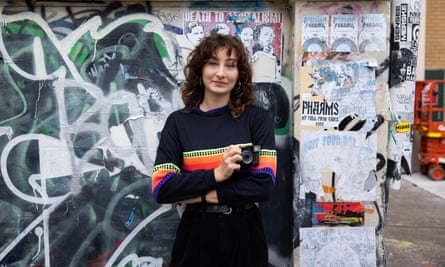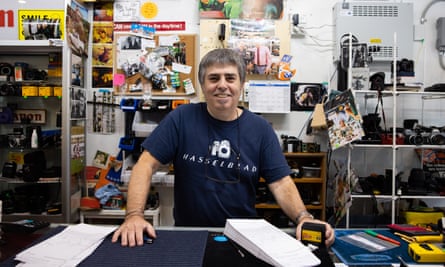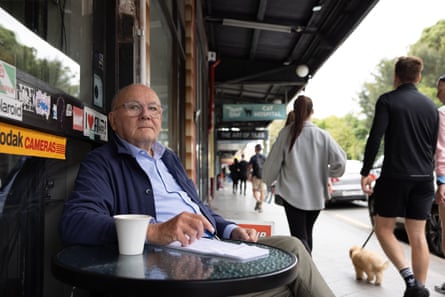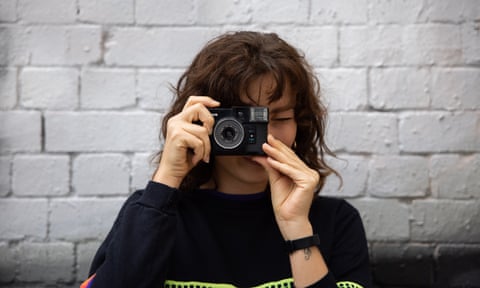Indi Shields first discovered film in the drawer of her childhood home. “The first film camera I picked up was my great grandfather’s,” she says. “It felt so special to hold it and use it in the same way that he used to. Even though I never got to meet him.”
While Shields was already taking analogue photographs before the pandemic began, the way she used it shifted during lockdowns. Where once the camera would only come out at big events like birthday parties, she found herself snapping away at “mundane things like my friend watching TV on the couch or the tunnel I walk through to get to the train – just because these are sweet little moments I want to look back on or remember in five or 10 years.”
This also yielded surprises, at a time when there weren’t many to be had. “During the lockdown, one joyful thing I had was sending my film away to get it developed. That was something to look forward to when there wasn’t anything else, even if I had no idea what I had taken photos of because I hadn’t been doing anything,” she says.

With lockdown life behind her, Shields has become a regular at Sydney Super8, one of the city’s pillars of modern-day photographic film.
Specialising in vintage cameras, film accessories and film processing, owner Nick Vlahadamis has watched as young people have used their lenses to turn back time. “In the last two years, film sales have increased 20-fold and processing has quadrupled,” he says.
“We opened in 2013, selling old cameras as ornaments. As time went on, more people wanted film cameras that worked, so we quickly took up the dead cause.
“By about 2015, we were developing 100 or so rolls [of film] a week.”
While Vlahadamis is adamant film isn’t as popular as it was in the 90s, he says the trend isn’t going away any time soon.
He points to the revival of Kodak, as an example. While Kodak filed for bankruptcy in 2012, the film giant ended 2020 with a cash balance of $196m – a whopping figure for a company that’s clawed its way back to relevance by riding a wave of nostalgia. “There’s something going on globally with film,” says Vlahadmis.


The Kodak figure makes sense in light of the rising prices for film paraphernalia. Riana Jayaraj says she bought her second-hand Olympus Stylus point-and-shoot for $30 a few years ago, and today, it’s being sold online for an average of ten times that price.
For Melbourne-based Jayaraj, her love for film is more than just a resurfaced pandemic-world trend. The 25 year-old fell for the vintage technology about five years ago, and now she carries her camera to important events. It’s her way of savouring the moment.
“I’ll take it out for [events] like my girlfriend’s wedding. I don’t take it everywhere, but if something’s on I will because then I can enjoy the experience.
“It helps me to capture little things along the way that I can look back on later, rather than worrying about taking photos on my phone.”
The lack of instant feedback is important for Jayaraj. “When you’re taking photos on your phone, it’s almost like you’re disconnected to what you’re actually doing – when you’re standing there hammering that camera button, you can kind of manipulate the scene or the situation you’re in … you can keep retaking it until you’re happy with it.”
“With film, you only have one shot – you take it and you just hope that it’s good. Because you don’t keep taking 50 million of them because you’ve only got like 35 shots on the roll and it costs money to get it developed.”
Jayaraj is not the only Gen Z member using film as an antidote to digital fatigue. Since finding film, she has watched it rise in popularity within her own friendship circle.
“I feel like everyone uses film now. Even a few of my friends have Instagrams for their film pictures,” she says.


Disposable cameras are also being ushered into the new age, as brands like 35mm Co pair the primitive technology with the millennial devotion to sustainability.
The Reloader is a modern-day reusable take on the disposable film camera, the creation of Madi Stefanis, a 21 year-old Melbourne-based student. After selling second-hand film cameras online and watching them fly off her digital shelves, she delved into product design.
“I wanted to launch a product that was suitable for all ages and skill levels, and reduced the need for single-use film cameras,” she said.
Since the launch of The Reloader, over 11,000 of them have been sold. Stefanis notes that most of her customer base are women, and young (in the 18 to 34 age range).
But why thumb through physical copies of grainy memories when we can capture the moment with a 12 megapixel wide-angle-lens?

For Shields, it’s the solace in “staying present” and an uncertain outcome, which to her “feels like magic” – unlike when she uses her phone.
“I actually have no idea where my digital camera is, it’s probably under my bed covered in dust and mould. But my film cameras are sitting on my mantelpiece, and they’re the first thing you see when you walk into my bedroom.”
“I feel so much more drawn to film because it’s so much more exciting,” she says. “There’s an element of surprise, and unknowing and creativity.”
